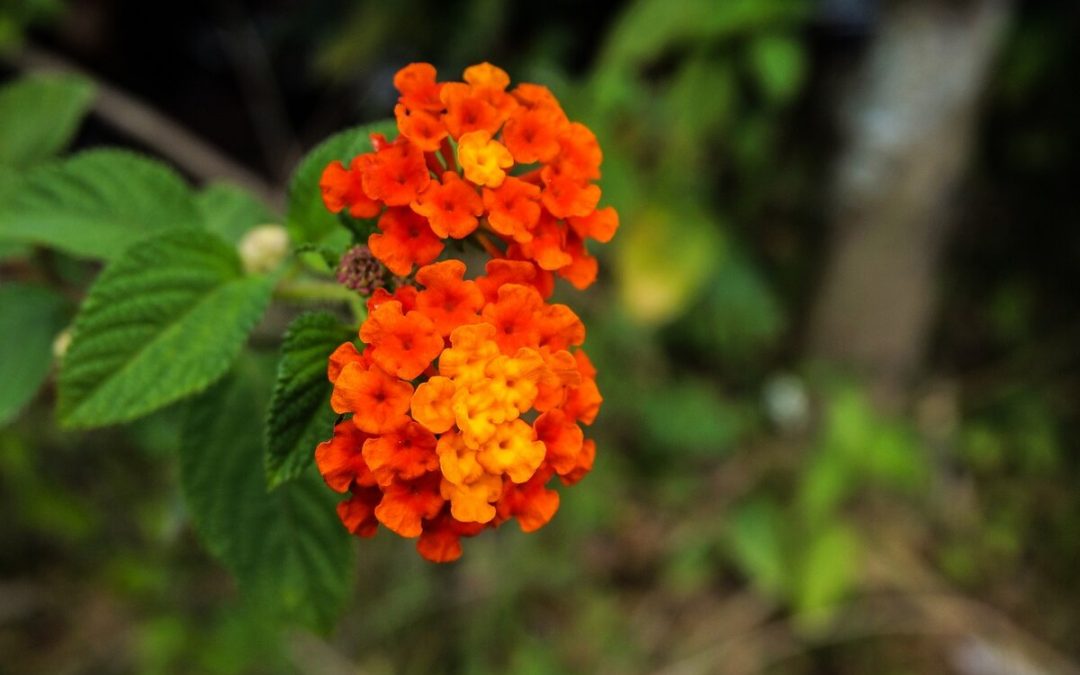Try as you might, you can’t get every plant to thrive in Central Texas’ humid subtropical climate. Why not give your garden a better chance with Texas native plants? The best native plants for Central Texas are much more likely to be:
- Eco-friendly
- Low-maintenance
- Drought-tolerant
- Resistant to disease and pests
- Wildlife and pollinator-friendly
Remember, Texas is a big state with several different climates. A plant that does well in the Panhandle or East Texas may not do well in Central Texas. Look for plants native to your region for the best results.
Let’s take a look at some of the best natives for Central Texas.
In this article, we’ll cover:
- 15 Best Native Plants for Central Texas
- How to Choose the Best Natives
- FAQ About the Best Native Plants
15 Best Native Plants for Central Texas
1. Ashe Juniper (Juniperus ashei)
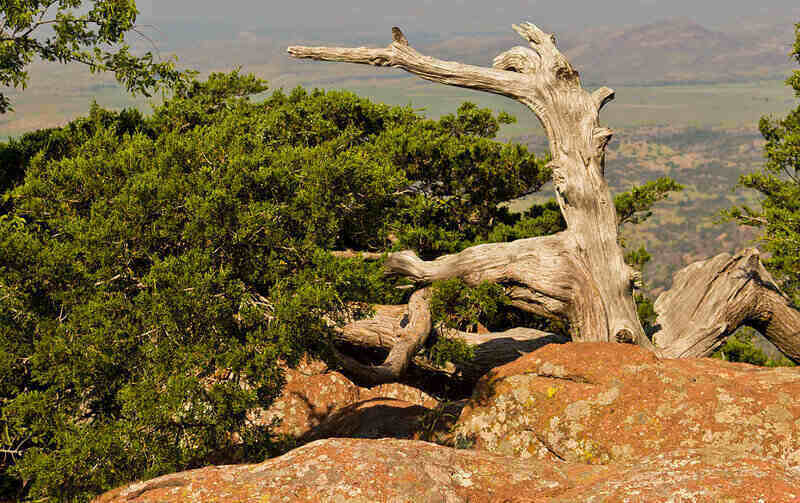
Photo Credit: katsrcool / Wikimedia Commons / CC BY 2.0
Central Texas has been home to the Ashe juniper for tens of thousands of years, so it certainly qualifies as a native. Its trunk may be twisted or grooved and is covered with shaggy bark, which golden-cheeked warblers use for nests. The branches start low on the trunk, sometimes very close to the ground. Ashe juniper can serve as a shade tree.
Female trees have blue seed cones that look like berries. Small mammals and birds snack on the seed cones, and butterflies visit its small flowers. When leaves drop off this small tree, they create rich, well-drained soil that benefits many local plants. Ashe junipers have a pleasant smell, but you may not enjoy breathing in its plentiful pollen. Anyone with cedar allergies may want to avoid this tree. It also may cause minor illness if ingested.
Growth habit: Tree
USDA Hardiness Zone: 7 to 9
Mature size: Up to 30 feet tall
Duration: Perennial
Foliage: Evergreen
Sunlight needs: Part shade
Soil preferences: Dry, well-drained soils made up of limestone, sand, loam, or clay
Water needs: Low
Potential hazards: Minor toxicity if eaten
2. Black-Eyed Susan (Rudbeckia hirta var. pulcherrima)
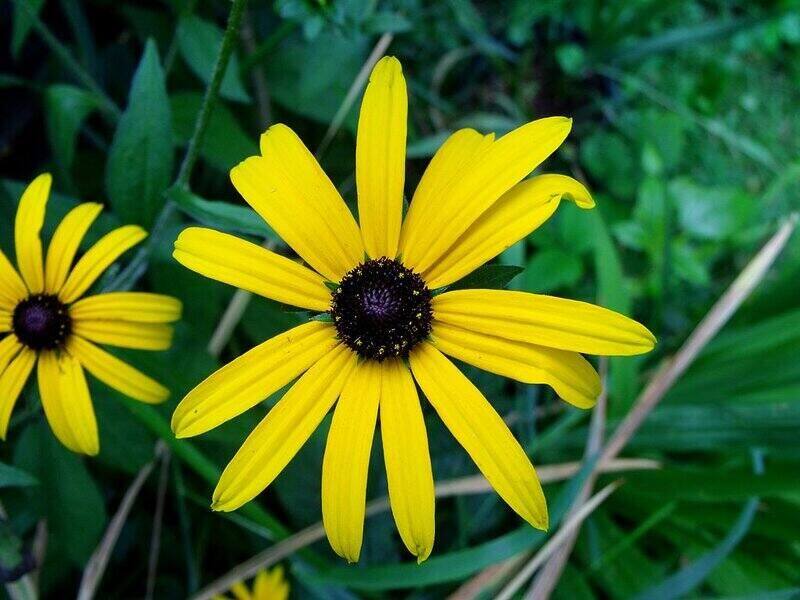
Photo Credit: grassrootsgroundswell / Wikimedia Commons / CC BY 2.0
Do you dream of your own personal meadow? Black-eyed Susans will add a lovely pop of color to your Texas landscape with their daisy-like yellow flowers and brown centers. They are native to 48 U.S. states and can bloom from spring to fall. Black-eyed Susans attract monarch butterflies and host silvery checkerspot larvae.
Though black-eyes Susans can survive in many conditions, they do best in full sun with dry, sandy soils. These flowering plants are safe for humans and pets, though they may cause skin irritation or allergic reactions if eaten.
Growth habit: Flower or herb
USDA Hardiness Zone: 2 to 11
Mature size: 1 to 3 feet tall
Duration: Perennial
Foliage: Deciduous
Sunlight needs: Full sun
Soil preferences: Can grow in most soil types but prefers dry and sandy soils
Water needs: Moderate
Potential hazards: Not poisonous to humans, but can be a skin irritant or cause allergic reactions if consumed; could be poisonous to grazing animals
3. Blackfoot Daisy (Melampodium leucanthum)
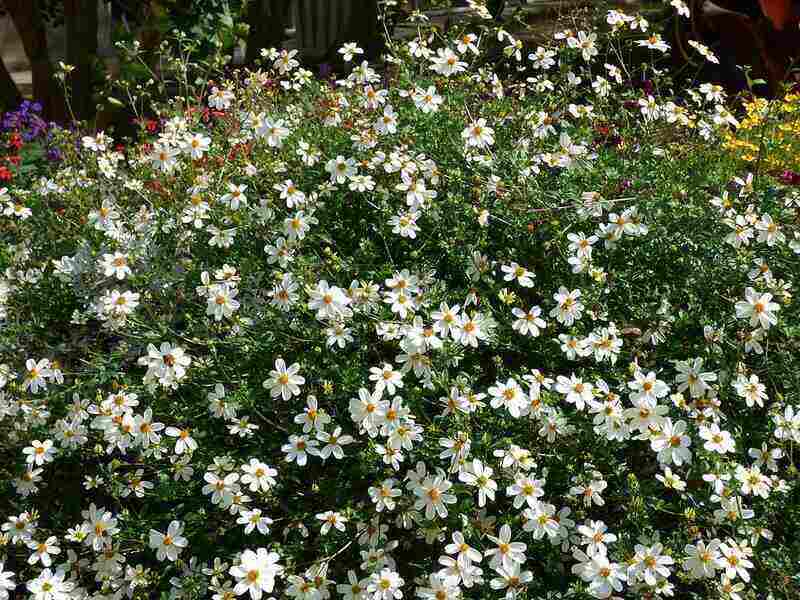
Photo Credit: Zbigniew Niepokój / Wikimedia Commons / CC BY-SA 4.0
Also known as plains blackfoot, this flower is native to prairies and meadows. These low, bushy plants produce 8 to 13 flowerheads per plant in spring and summer. Blackfoot daisies are white with a yellow center and smell like honey. Their nectar attracts bees, butterflies, and insects, while the seeds appeal to birds.
Blackfoot daisy is relatively heat, drought, and deer-resistant. You can encourage more flowers with rich soil and abundant water, but this will likely result in a shorter lifespan. This flower is popular for rock gardens since it prefers rocky and sandy soils. It’s also a good choice for dog owners since it’s safe for pets and humans.
Growth habit: Flower or herb
USDA Hardiness Zone: 4a to 11b
Mature size: 6 to 12 inches tall
Duration: Perennial
Foliage: Evergreen
Sunlight needs: Sun or partial shade
Soil preferences: Prefers acidic, dry, rocky, gravelly, and sandy soils that are well-drained
Water needs: Low
Potential hazards: Non-toxic
4. Cardinal Flower (Lobelia cardinalis)
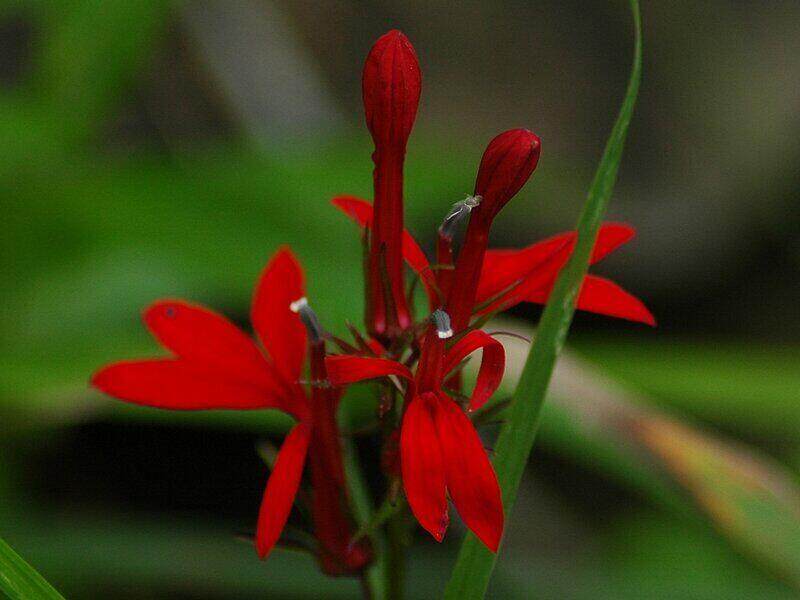
Photo Credit: linnaeus / Wikimedia Commons / CC BY 3.0
Like the bird it shares a name with, these flowers are brilliant red. They attract hummingbirds and butterflies. Cardinal flowers die back in winter, but the shiny leaves resist cold. This plant is a good candidate for container gardens or border plantings. Watch out for snails and slugs which may wish to make a meal of the foliage.
Cardinal flowers are generally low-maintenance. However, they will require frequent watering to maintain the moist soil they prefer. Some afternoon shade will shield them from the heat and prevent them from drying out. While historically used for medicine, all parts of the plant are poisonous. It’s not the best choice for parents or pet owners.
Growth habit: Flower or herb
USDA Hardiness Zone: 3a to 9b
Mature size: 1 to 6 feet tall
Duration: Perennial
Foliage: Deciduous
Sunlight needs: Full sun or partial shade
Soil preferences: Rich, moist soil
Water needs: Moderate to high
Potential hazards: Can be toxic if large quantities are eaten
5. Flame Acanthus (Anisacanthus quadrifidus)
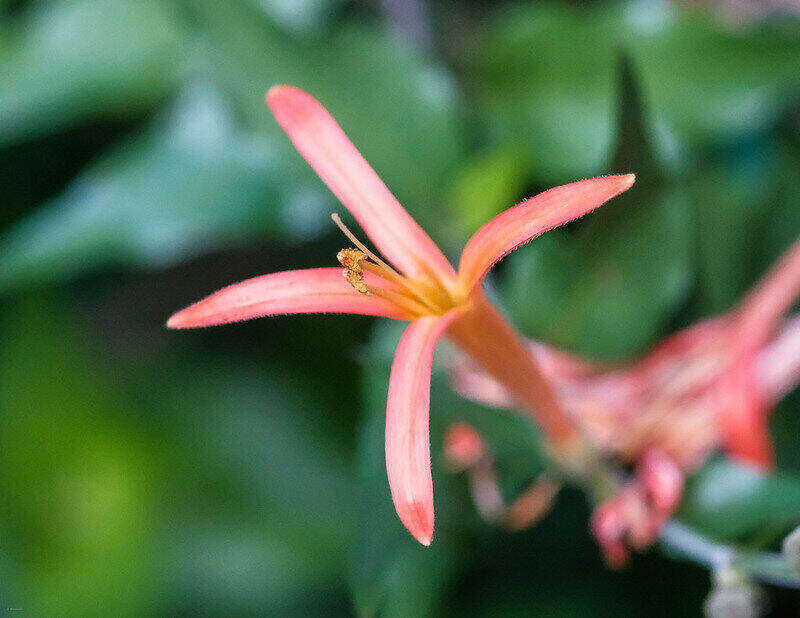
Photo Credit: Earl McGehee / Flickr / CC BY-SA 2.0
Also known as Mexican flame or hummingbird bush, this deciduous shrub is native to Central and South Texas. Its red-orange tubular flowers bloom from summer to fall and are especially prolific when it rains. Flame acanthus attracts hummingbirds and butterflies, hosting janais patch and Texan crescentspot larvae. Its bark is exfoliating, and its light-green leaves have a spearhead shape.
Flame acanthus is native to areas with rocky, calcareous soils but can adapt to heavier soils. Since it is drought and heat tolerant, it does well in xeriscapes. You can use it in landscapes, pots, and dense, low hedges.
Growth habit: Shrub
USDA Hardiness Zone: 7 to 10
Mature size: 3 to 5 feet
Duration: Perennial
Foliage: Deciduous
Sunlight needs: Sun or partial shade
Soil preferences: Well-drained sand, clay, loam, caliche, or limestone
Water needs: Low
Potential hazards: None
6. Halberd-Leaved Rose-Mallow (Hibiscus laevis)
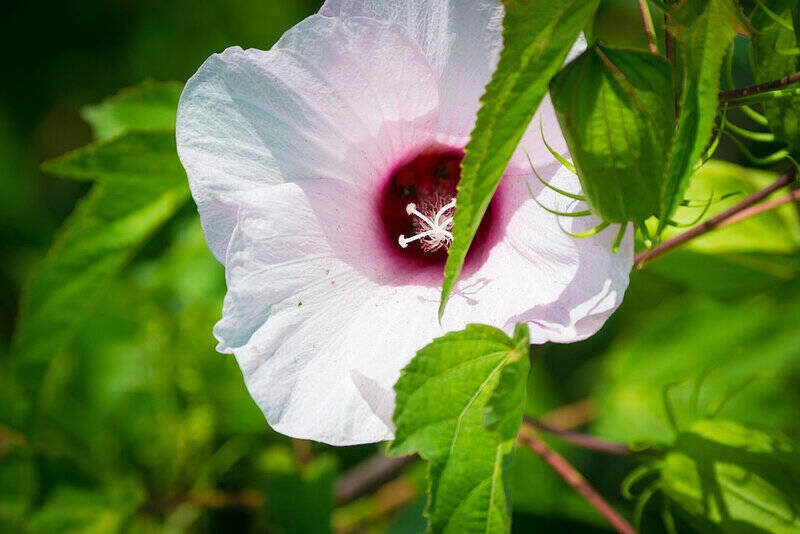
Photo Credit: Andrew C / Wikimedia Commons / CC BY 2.0
Whether you call it a rose-mallow or hibiscus, this flowering plant adds a tropical charm to your garden. Though it resembles various imported hibiscus, the halberd-leaved rose-mallow is native to marshes in North Central Texas. The pink or white flowers bloom between May and November, opening in the daytime and closing at night.
Halberd-leaved rose-mallows are low-maintenance with few insect and disease problems. They are excellent border plants for rain, butterfly, or pollinator gardens. They also do well on properties near ponds and streams. If you want to plant more, you can collect seeds in the summer from your existing plants. This type of hibiscus is safe for humans, dogs, and cats.
Growth habit: Shrub
USDA Hardiness Zone: 4a to 9b
Mature size: 4 to 6 feet tall
Duration: Perennial
Foliage: Deciduous
Sunlight needs: Sun or partial shade
Soil preferences: Tolerates wet, acidic, sand, loam, or clay soils
Water needs: High
Potential hazards: Non-toxic
7. Lemon Beebalm (Monarda citriodora)
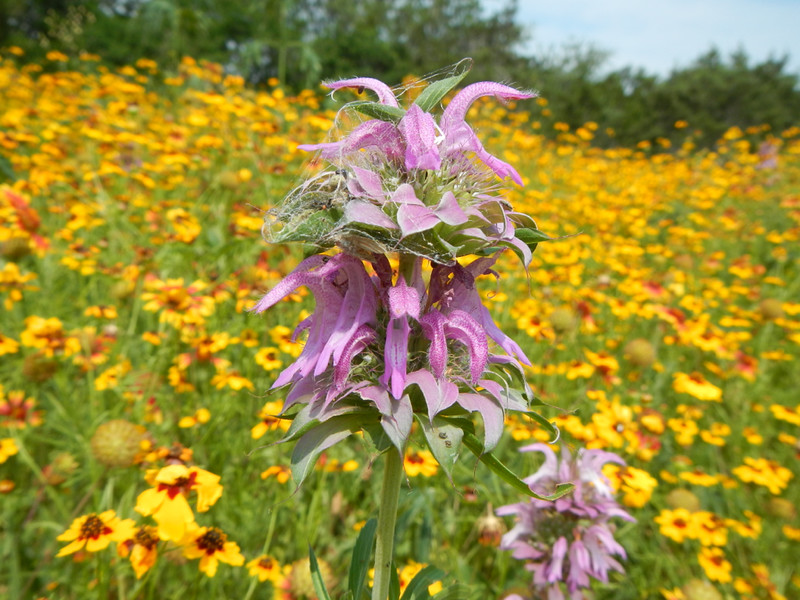
Photo Credit: John Hayes / Flickr / CC BY 2.0
Lemon mint or beebalm gets its name from its citrusy smell. White, lavender, or pink flowers encircle the stem, blooming in spring, summer, and sometimes fall. Bees love this plant, but so do hummingbirds and butterflies. It’s also edible for humans — use the leaves in salad, tea, or other culinary creations.
Since it’s an annual, lemon beebalm will die off each year, though it can reseed itself. However, its aggressive growth can be a double-edged sword if you want to keep it contained. It’s a good choice for backyard meadows and edible gardens. Keep an eye out for powdery mildew.
Growth habit: Flower or herb
USDA Hardiness Zone: 4a to 9b
Mature size: 1 to 4 feet tall
Duration: Annual
Foliage: Deciduous
Sunlight needs: Full sun or partial shade
Soil preferences: Dry, sandy, loamy, rocky, or clay
Water needs: Low
Potential hazards: None
8. Pink Evening Primrose (Oenothera speciosa)
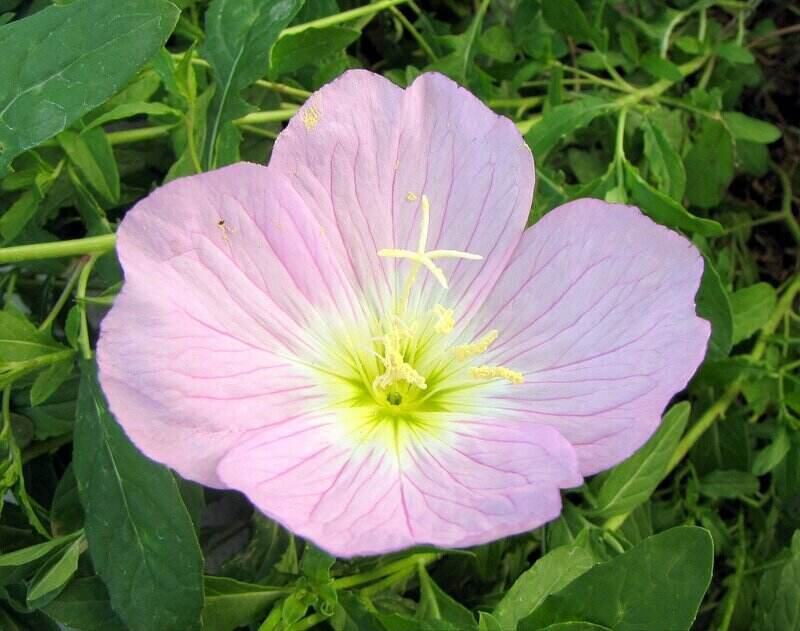
Photo Credit: ZooFari / Wikimedia Commons / CC BY-SA 3.0
This plant produces fragrant pink or white cup-shaped flowers. Though the name suggests pink evening primroses flower in the evening, they usually open in the morning in the American South. They also tend to be darker pink than northern populations. Pink evening primrose can bloom whenever temperatures are above freezing, but each flower only lasts a day. The flowers attract bees and birds, especially finches.
This species is hardy and drought-resistant, but flowers will be smaller during dry spells. It may also go dormant if soils dry up entirely in summer — water sparingly to prevent this. Pink evening primroses are an excellent dense ground cover for xeriscapes, though they may aggressively spread if you aren’t careful. They will only bloom if in full sunlight. Though this plant is generally low-maintenance, you can fertilize it in spring to encourage flowering.
Growth habit: Flower or herb
USDA Hardiness Zone: 4 to 9
Mature size: 1 to 2 feet tall
Duration: Perennial
Foliage: Semi-evergreen
Sunlight needs: Full sun
Soil preferences: Prefers well-drained soils that are dry, moist, fertile, poor, loamy, clay, sandy, or gravely
Water needs: Low to moderate
Potential hazards: None
9. Purple Coneflower (Echinacea sp.)
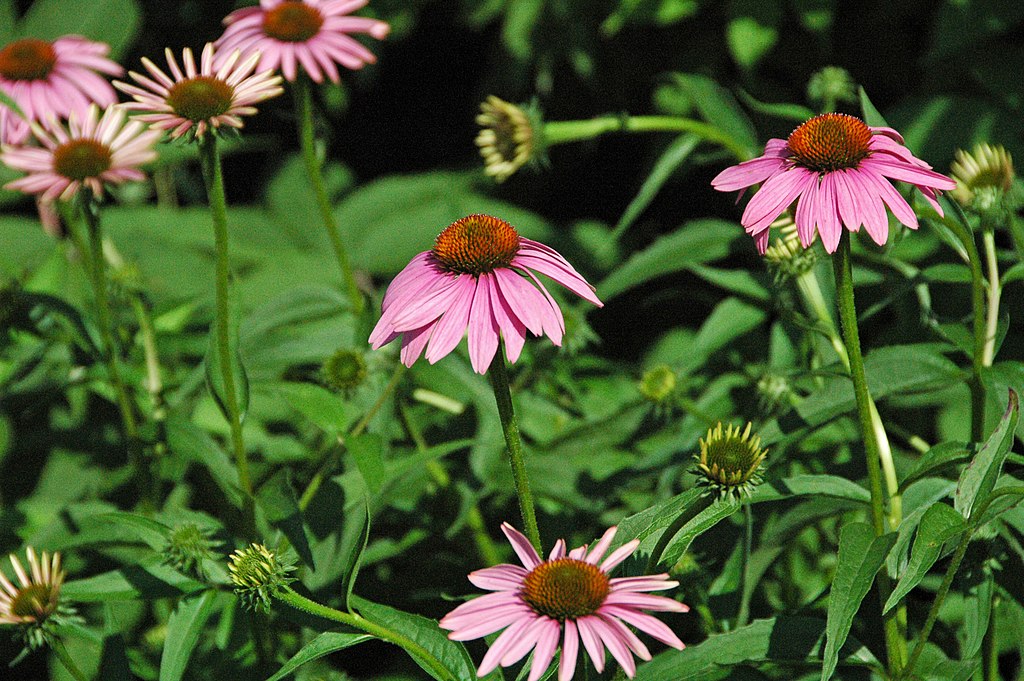
Photo Credit: James St. John / Wikimedia Commons / CC BY 2.0
These flowers look like purple daisies, each with its own stem. The flowers bloom from June to October and attract butterflies and bees. Though many species share a common name, Echinacea purpurea and Echinacea angustifolia are the best fits for Texas.
Purple coneflower’s low-maintenance, drought tolerance, and summer flowers make it a welcome addition to Texas gardens in groupings or borders. They also look lovely when cut for a vase or bouquet. Though purple coneflowers have few disease and pest problems, Japanese beetles may eat their leaves and flowers.
Growth habit: Flower or herb
USDA Hardiness Zone: 3a to 8b
Mature size: 2 to 4 feet tall
Duration: Perennial
Foliage: Deciduous
Sunlight needs: Prefers full sun but tolerates light shade
Soil preferences: Fertile, well-drained soil
Water needs: Moderate
Potential hazards: May cause allergic reactions if consumed
10. Rock Rose (Pavonia lasiopetala)
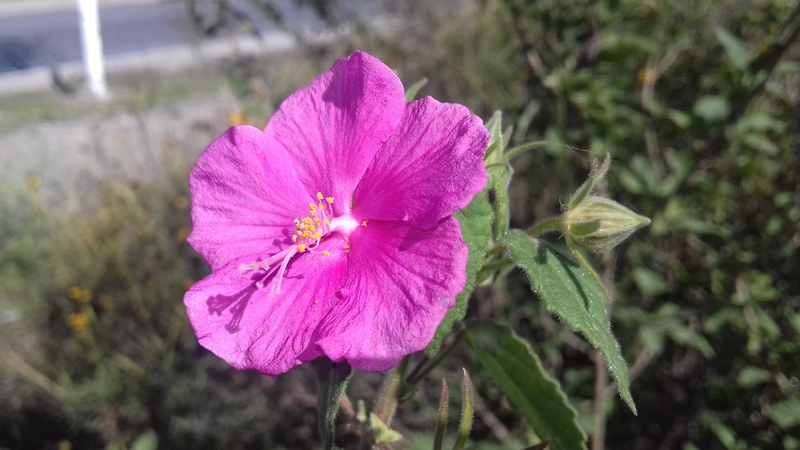
Photo Credit: PxHere
While it may not be a traditional rose, this ornamental shrub still rocks. The rock rose blooms from spring until the first frost. The pink flowers attract various pollinators. When not in bloom, you can enjoy its dark green leaves with a frosted appearance. Use in flower beds, border plantings, rock gardens, or xeriscapes.
Though it’s native to the Hill Country, Texas A&M AgriLife Research has designated this shrub a Texas Superstar due to its versatility throughout the state. Rock roses can handle several types and tolerate sun, heat, and drought. It’s also easy to propagate, accessible, and affordable. Though this evergreen shrub tolerates shady areas, it will bloom less and be more susceptible to powdery mildew.
Growth habit: Small shrub
USDA Hardiness Zone: 8 to 13
Mature size: 2 to 4 feet tall
Duration: Perennial
Foliage: Evergreen
Sunlight needs: Full sun to light shade
Soil preferences: Well-drained soils of various fertility and pH levels
Water needs: Low
Potential hazards: None
11. Standing Cypress (Ipomopsis rubra)
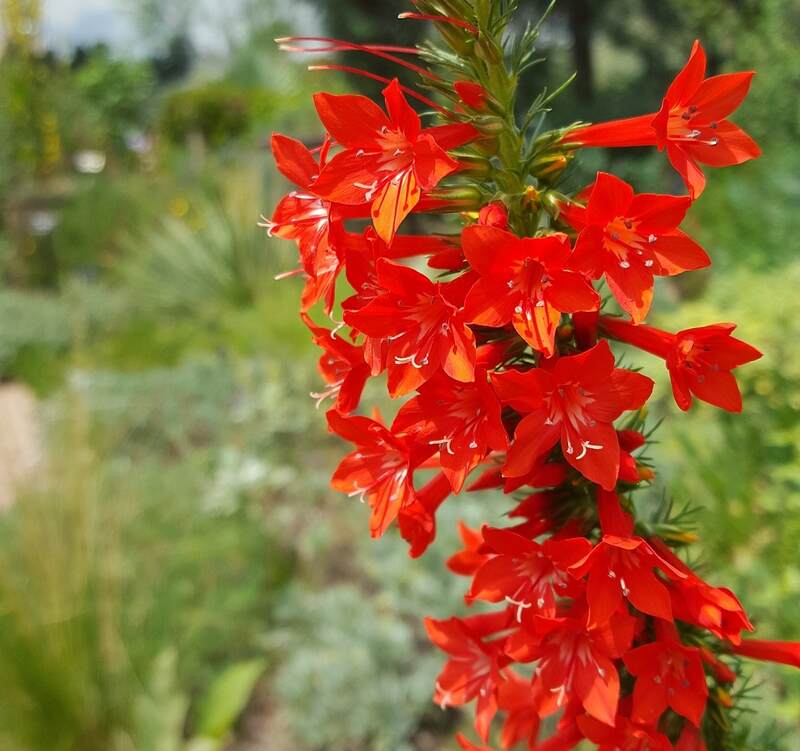
Photo Credit: Pixabay
These plants live up to their name — they stand up straight and tall, showing off tubular red, orange, or yellow flowers on stiff stems. They can grow up to 6 feet tall but are usually shorter. The opening of the standing cypress flower resembles a star. These flowers are great for ornamental or hummingbird gardens.
Standing cypress is drought-tolerant and low-maintenance. Since this plant is biennial, you must replant it to enjoy it for more than two years. It will develop in the first year and flower in the second, so plant them yearly if you want flowers every season. You can prune stalks that are done blooming to encourage new growth and flowering.
Growth habit: Flower or herb
USDA Hardiness Zone: 6 to 9
Mature size: Up to 6 feet tall
Duration: Biennial
Foliage: Semi-evergreen
Sunlight needs: Full sun or partial shade
Soil preferences: Dry, well-drained sand, loam, or limestone
Water needs: Moderate
Potential hazards: None
12. Texas Lantana (Lantana urticoides)
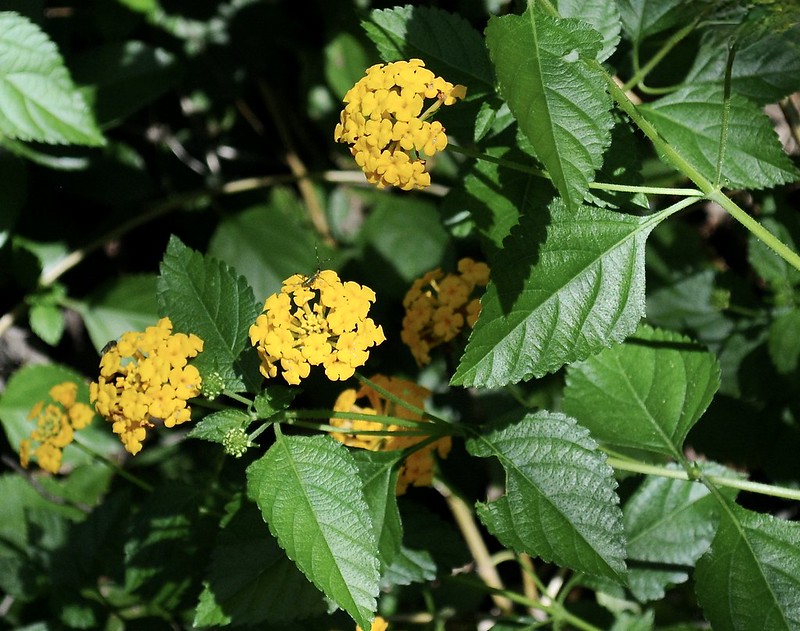
Photo Credit: sonnia hill / Flickr / CC BY 2.0
Do you need a drought-resistant ground cover with few pest and disease problems? Texas lantana produces round clusters of yellow, orange, and red flowers. Your local butterfly and hummingbird population will feed on its nectar, and birds will snack on its black seeds. Texas lantana blooms from spring until the first frost, then dies back. You can protect this plant from the cold with mulch.
You can occasionally prune Texas lantanas during the growing season to encourage new flower growth, but be warned — this plant’s leaves release an unpleasant odor when pruned or crinkled. Its toxicity makes it deer-resistant, but you must also be careful around it if you have pets or children. Consuming any part of these native shrubs could be fatal.
Growth habit: Shrub
USDA Hardiness Zone: 8
Mature size: 2 to 6 feet tall
Duration: Perennial
Foliage: Deciduous
Sunlight needs: Full sun or partial sun
Soil preferences: Tolerates many soil types but prefers well-drained sandy and gravelly soils
Water needs: Low
Potential hazards: All parts are poisonous if ingested
13. Texas Prickly Pear (Opuntia engelmannii var. lindheimeri)
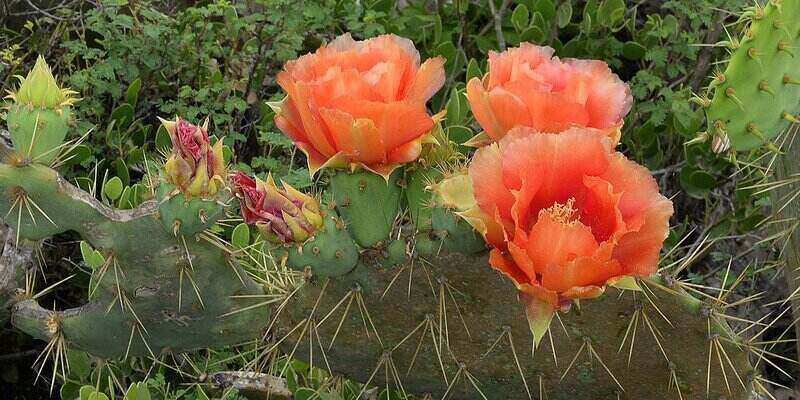
Photo Credit: William L. Farr / Wikimedia Commons / CC BY-SA 4.0
The Texas prickly pear is common in Central and South Texas. This succulent has a good heat tolerance and does better the more south you go. It can grow tall or form spread-out thickets up to 8 feet across. Bowl-shaded red, yellow, or orange flowers bloom in June. From July to September, those flowers will produce red to purple fruits called tuna.
The prickly pear fruit and pads are edible for humans and animals, but the older pads may cause oxalic acid poisoning. You should also watch out for the spines and barbed bristles. They are difficult to remove from your skin, so this plant may not be suitable for curious children and pets.
Growth habit: Succulent or shrub
USDA Hardiness Zone: 8
Mature size: Up to 9 feet tall
Duration: Perennial
Foliage: Evergreen
Sunlight needs: Full sun
Soil preferences: Dry soils with acidic or neutral pH
Water needs: Low
Potential hazards: Painful spines and bards; oxalic acid poisoning from consuming old prickly pear pads
14. Texas Sage (Salvia texana)
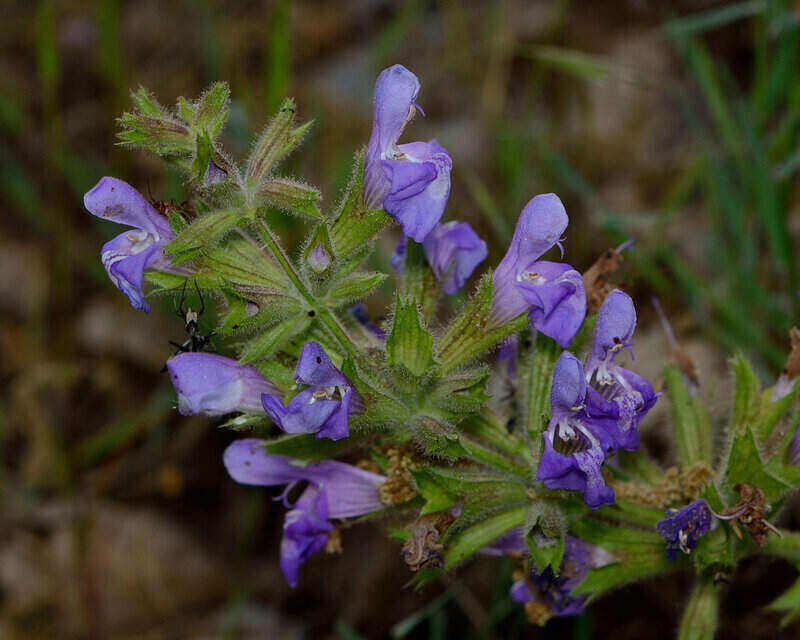
Photo Credit: Gideon Pisanty / Wikimedia Commons / CC BY 3.0
Bring the prairie to your home with Texas sage. This plant is native to the well-drained limestone soils in Texas and Mexico. The delicate, purple-blue blooms attract bees, butterflies, and hummingbirds while releasing a fragrant scent. The flowers bloom from March through May.
Texas sage can survive many challenges nature sends its way. It’s resistant to cold, heat, drought, and deer. It does well when used as a ground cover or in xeriscapes. Pair Texas sage with other purple flowers and short prairie grasses.
Note: Another Texas native, Leucophyllum frutescens, shares the name Texas sage but is also called Texas barometer bush or cenizo.
Growth habit: Flower or herb
USDA Hardiness Zone: 6a to 9b
Mature size: Up to 24 inches tall
Duration: Perennial
Foliage: Deciduous
Sunlight needs: Full sun or partial shade
Soil preferences: Well-drained and alkaline soils that are sandy or clay
Water needs: Low
Potential hazards: None
15. Yellow Sundrops (Calylophus serrulatus)
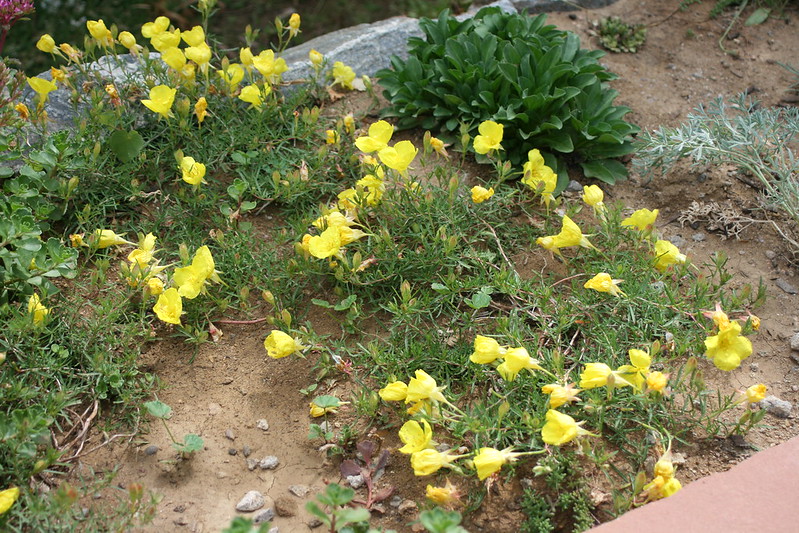
Photo Credit: Patrick Standish / Flickr / CC BY 2.0
Sometimes called yellow evening primrose or plains evening primrose, this plant will bring sunshine into your life with its cheery four-petaled flowers. Sundrops bloom from April until July, though the loveliest flowers appear at the beginning of the season. The rest of the plant is bushy with thin leaves.
Since its native habitat is plains and prairies, this plant does well in hot, dry weather. It tolerates many conditions and fits xeriscapes or rock gardens well. For the best growth, cut back in the spring and apply mulch in winter for cold protection.
Growth habit: Flower or herb
USDA Hardiness Zone: 5 to 9
Mature size: 8 to 30 inches tall
Duration: Perennial
Foliage: Evergreen
Sunlight needs: Full sun
Soil preferences: Dry and well-drained; tolerates clay, loam, and sand
Water needs: Low to moderate
Potential hazards: None
How to Choose the Best Central Texas Natives for Your Landscape
The easiest way to gauge a plant’s suitability for your area is to check its USDA Hardiness Zone. The USDA Hardiness Zone measures the annual minimum temperature in an area. Central Texas falls in zones 7b to 8b, which experiences temperatures as low as 15 degrees Fahrenheit. If a plant falls within these zones, it can likely tolerate the temperatures in the area.
Temperature and hardiness zone aren’t everything. Soil conditions also affect a plant’s growth ability. Though general soil maps can provide some information, a soil test will give you the best idea of your garden bed’s texture and nutrient content. Other microclimate factors affecting plant growth include moisture, salinity, and sun or shade levels.
The last but most important consideration is your personal preferences. Do you want flowering, edible, or pet-safe plants? How much time do you have for maintenance? Though most native plants are low-maintenance, some may require additional pruning, irrigation, and fertilization to get the results you want.
FAQ About the Best Native Plants for Central Texas
The following drought-tolerant plants need less water than most:
• Blackfoot daisy
• Flame acanthus
• Lemon beebalm
• Rock rose
• Texas lantana
• Texas prickly pear
• Texas sage
If you want a native groundcover, consider the following from our plant list:
• Pink evening primrose
• Texas lantana
• Texas sage
The best turfgrasses for Central Texas are:
• Bermudagrass
• Buffalograss
• St. Augustinegrass
• Texas bluegrass
• Buffalograss
The Final Word
Do you need help jumpstarting your native plant landscape design? Whether you live in Austin, Pflugerville, Round Rock, or any other Texas city, our landscaping professionals can do the heavy lifting and provide expert advice.
Main Photo By: Pixabay

